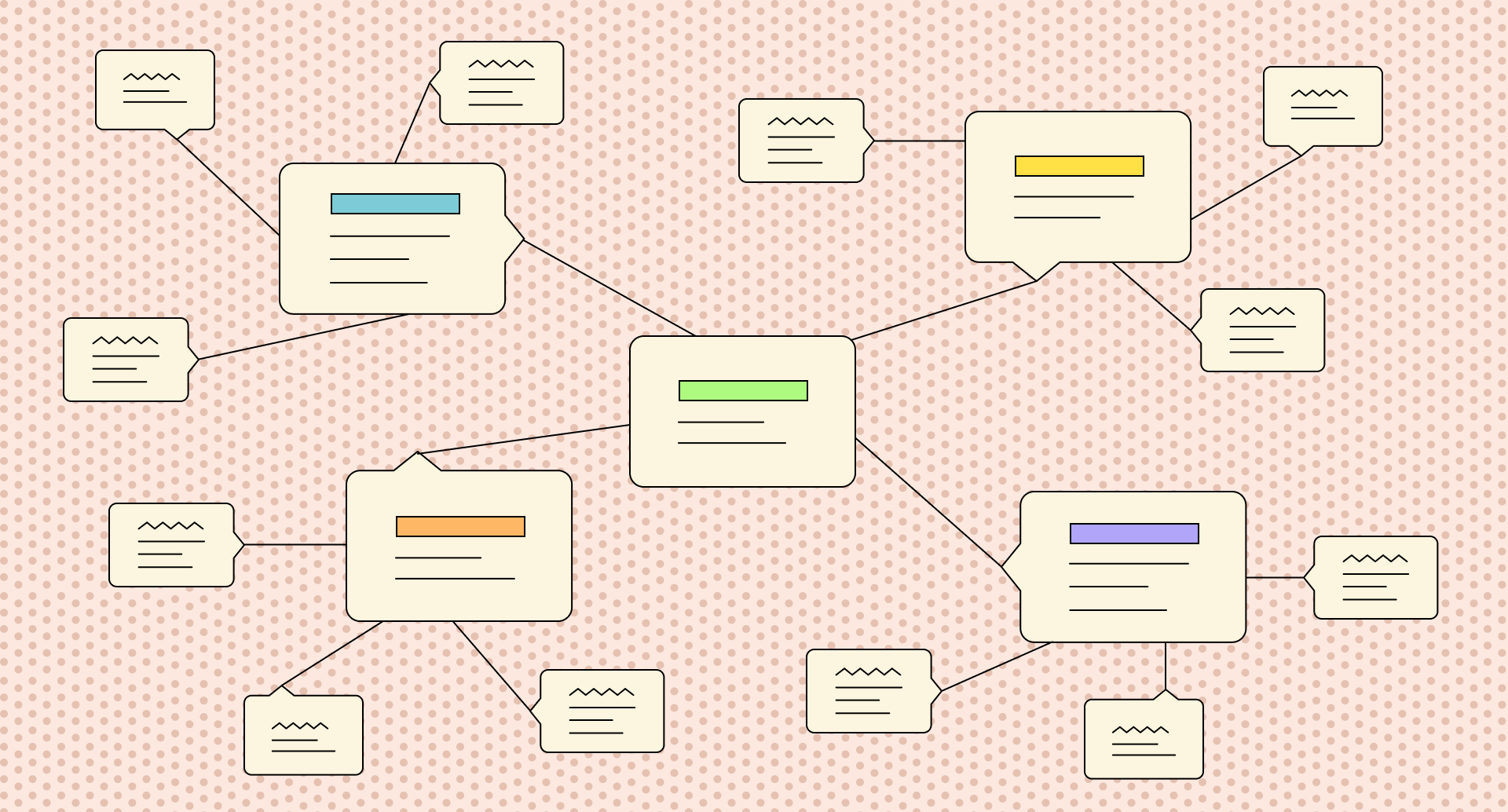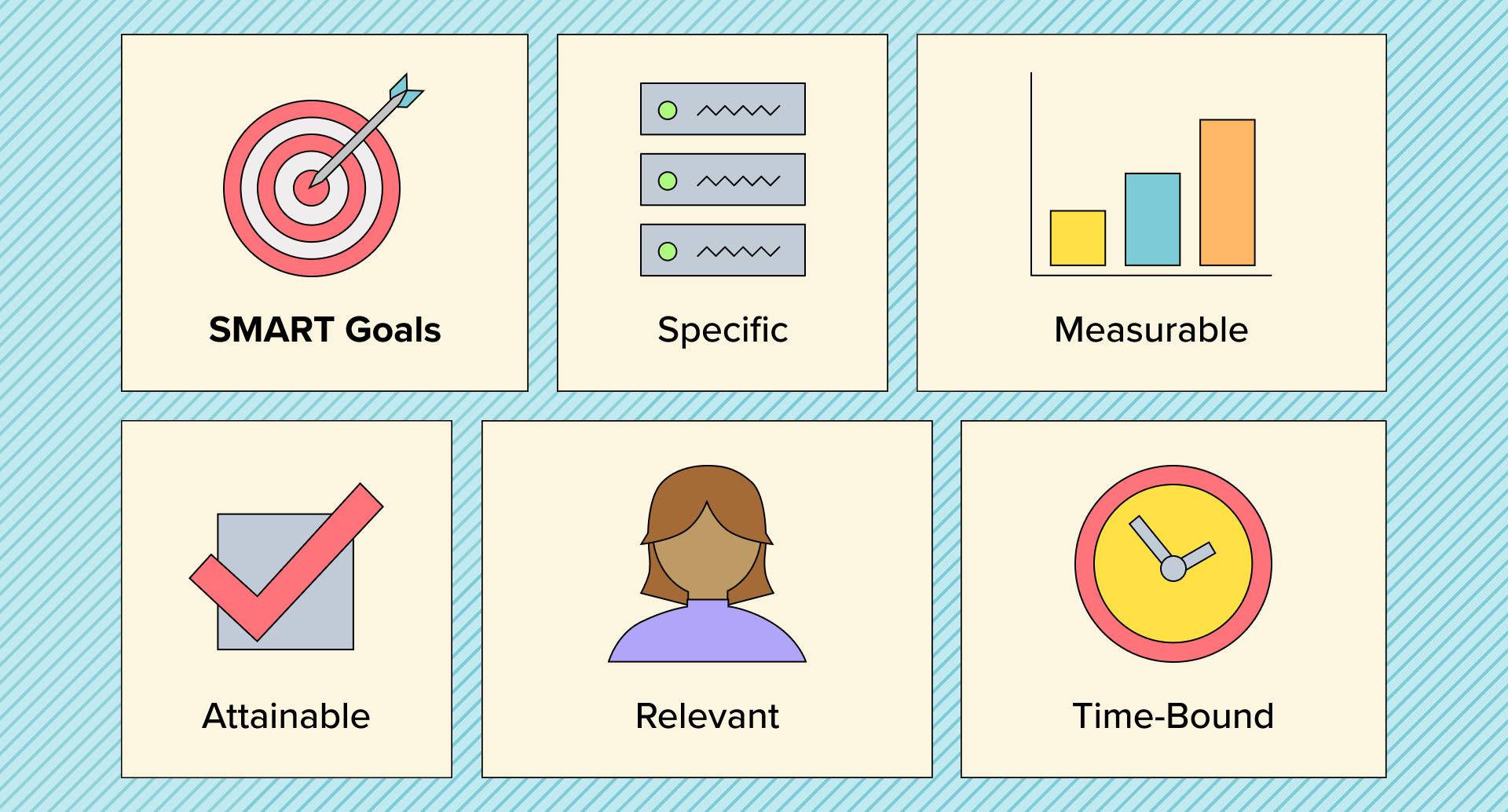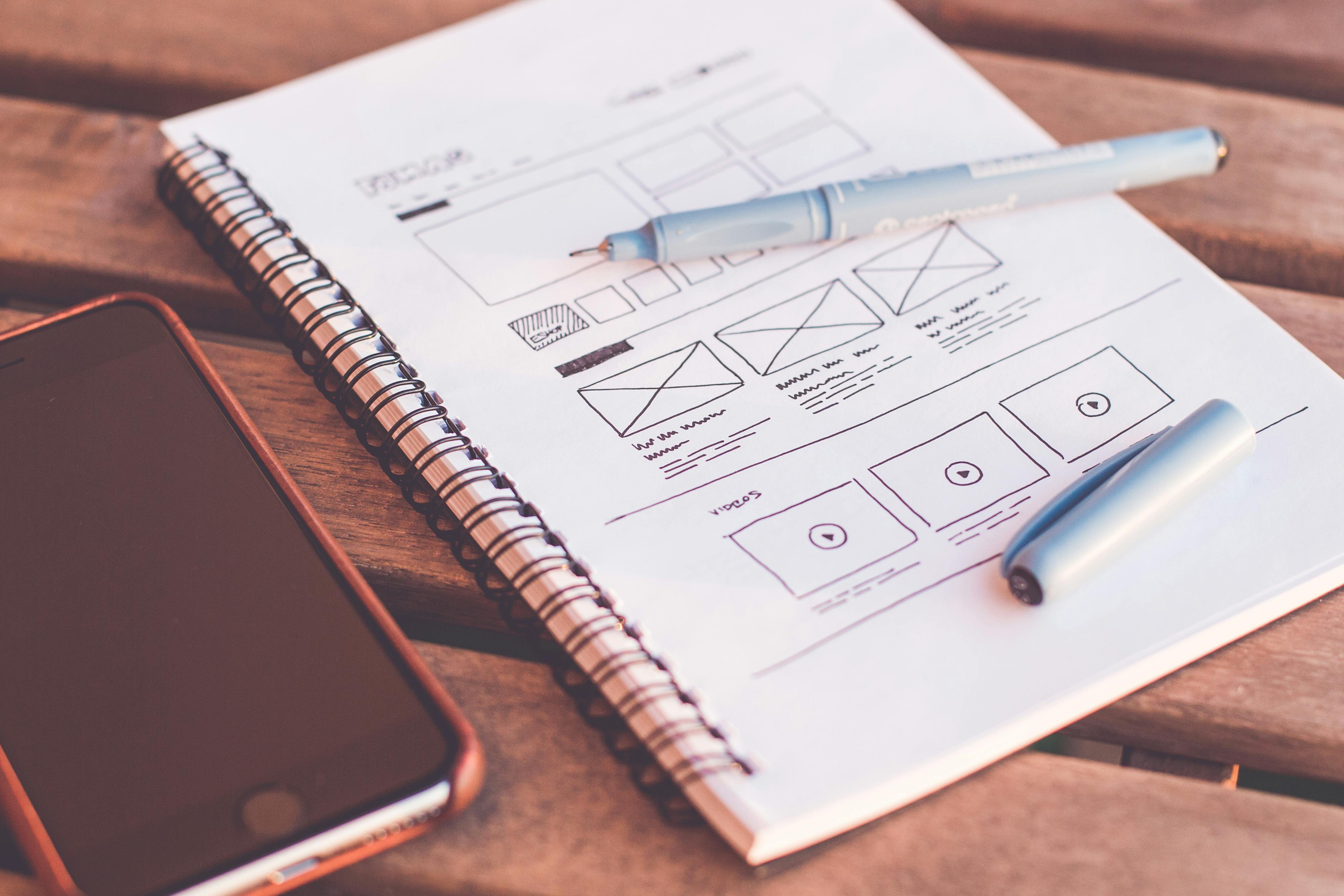No matter what month you stumble across this blog post, achieving growth through goal setting is always possible. While mantras and meditations are a great daily practice, breaking your dreams down into digestible and tangible goals will help you achieve more in the long run.
In this post, we’ll use the example goal of switching to a career in UX/UI design, but this framework can really be used to accomplish any type of goal (like Objectives and Key R esults (OKR) planning—check out this free OKRs template).

Where to Begin: Mind Mapping
If you know you want to start setting goals, but you aren’t yet 100% clear on what you want your goal to be or how to achieve it, we’d recommend starting with a mind map.
Mind mapping is a creative brainstorming process that helps to de-clutter your brain. It’s like pulling everything out of your closet for Spring cleaning.
If you know what it is, place your overall goal in the middle of the mind map and then create thought bubbles around it for the smaller sub goals and actions. Otherwise, use your mind map to brainstorm goal possibilities and get really clear on what you want.
You’d be surprised by how fun mind mapping can actually be and what sort of realizations about yourself you can uncover. This process works particularly well if you’re a visual thinker.
While there are lots of choices for mind mapping software, I’d recommend using a plain old pen and paper at this stage. Scientists say you are 42% more likely to achieve your goals if you write them down. But if you’re anti-paper, try Freemind: it’s open source and free.
Using happiness as your north star, try asking yourself these questions during the mind mapping process when trying to uncover your clearly-defined goal:
- What makes me happy?
- Why do these things make me happy?
- What are the things I’m willing to give up in order to be happier?
- What can I add more of in my life to be happier?
Once you’ve decided on your goal, try using these career-specific questions and a mind map to determine what needs to happen in order to achieve said goal:
-
Is there any professional training I can take? (Full-time, part-time, one-time, etc.)
-
What sort of supplemental materials will it require? (Portfolio, resume, LinkedIn, etc.)
-
Can I afford to leave my current job? (Savings, job market, family support, etc.)
-
What soft skills can I work on developing to help with the job hunt? (Presentation skills, communication skills, writing skills, etc.)
Hopefully at the end of this process, you’ll have a clearly-defined goal, and a broad idea of what needs to happen in order to achieve that goal.

Breaking Down the SMART Goals Formula
You’ve likely heard the term SMART Goals before. There are several variations on this concept, but I’ve found this time-tested formula for goal setting to be ideal. (See the end of this section for a free SMART PDF template.)
S = Specific (Alt Meanings: Significant, Stretching)
Whatever your goal or goals, they should be specific. It’s okay to start with a general goal, but the more specific your goal becomes, the easier it will be to plan and track your progress. Hopefully at this point you’ve used a mind map to get clear on what you really want.
Goals will typically fall into one of these categories:
- Education
- Career
- Finance
- Family
- Physical
For example, your career goal could be, “I will make the switch to a career in UX/UI design by enrolling in UX Academy.” 😉
M = Measurable (Alt Meanings: Meaningful, Motivational)
Now you need to establish how you will measure your goal and your progress. These can be in the form of monthly, weekly, or even daily check-ins.
With an educational goal, like graduating from UX Academy, measuring your success becomes easier as you have mentors for critical feedback, peers for Group Crits, and Career Services for industry benchmarking.
A = Attainable (Alt Meanings: Achievable, Agreed-Upon)
One way to be sure you don’t reach your goals is to set unattainable ones. While my personal life motto is, “Shoot for the stars, land in the clouds,” I’ve had to learn the hard way that nothing is possible without sacrifice.
However, we all know some things are sacred and can’t be sacrificed. For example, if you’re a mother hoping to make a career switch, you’ll need to seriously consider whether there are enough hours in the day for you to both be a full-time student and a full-time mother.
Luckily, most educational platforms have part-time options, which might be a more attainable goal for people with other important priorities, even though it will take more time to complete.
If you set goals that are unrealistic and unattainable, you’ll end up feeling like you have failed, which can affect your confidence. So, set goals that are both realistic, and challenging.
R = Relevant (Alt Meanings: Realistic, Results-Oriented)
Maybe you have a 5-year or 10-year plan and every January you set goals for that year which will all bubble up to your big, long-term personal and professional goals.
If you want to go further in life than you ever imagined possible, the goals you set each year should be relevant to you and your biggest hopes and dreams.
Continuing with our career-switching into UX/UI example, here are some relevant milestones you can set:
- Take prep-courses (like Design 101)
- Get accepted into UX Academy
- Graduate from UX Academy
- Apply to 20 jobs
- Land job
Keeping your goals aligned with the direction that you want your life to go will help you stay focused on achieving the bigger picture.
T = Time-Bound (Alt Meanings: Tangible, Trackable)
We’d recommend breaking your goals down into these time-bound chunks, with the following advice from Bill Gates in mind: “Most people overestimate what they can do in one year, and underestimate what they can do in ten years.”
- 5-year plan
- 1-year plan
- 6-month plan
- 1-month plan
- Weekly plan
- Daily to-do-list
Some people adhere to the principles of Stephen R. Covey, author of the classic The 7 Habits Of Highly Effective People, who says that a week should be your smallest unit of time.
Either way, setting a deadline will help you know when you’re falling behind and when you should celebrate success, and will provide a necessary sense of urgency in order to get the job done in a timely fashion.
To help you with this process, we’ve created a SMART Goals planning template. Download it here!

Learn To Be Flexible
You change, the people around you change, and the world changes.
If you start something and decide it isn’t actually the goal you want and the direction you want to move in, allow yourself the flexibility to know when it’s best to move on.
When we’re setting creative goals, being flexible is even more important. Tools change and improve, dream job listings come and go, and subjective design opinions change regularly. Adaptability is key to a successful creative career.
Don’t Forget to Celebrate Your Achievements
Since the beginning of time, people have used celebrations, like bar mitzvahs, baptisms, and weddings, to mark turning points. Whether for a group or for an individual, celebrations such as these strengthen bonds, vision, and values.
Make sure to celebrate your achievements and take the time to honor both your efforts and those who have supported you on your journey.
This celebration can be as simple as doing a victory dance around your living room after completing your daily lesson in UX Academy, or as big as taking yourself to Disney World when you graduate.
Start planning those celebrations now and give yourself something to look forward to when you inevitably crush your goals—we know you will!
Illustrations by Annie Devine
Thinking about switching to a career in design in 2020? Check out our UX Academy program and grab your free syllabus.



.svg)







%20(1)-min.png)

.png)




